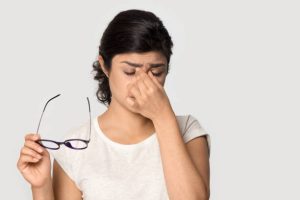OPENING TIME: MON-SAT (8:00AM-8:00PM*)SUN:8:00AM-1:00PM
Low Vision
Low vision is a significant visual impairment that cannot be corrected fully with standard glasses, contact lenses, medication, or surgery. It interferes with the ability to perform everyday activities such as reading, writing, watching television, recognizing faces, and driving.
Causes of Low Vision
Low vision can result from a variety of conditions and diseases, including:
- Age-Related Macular Degeneration (AMD): Damage to the central part of the retina, leading to loss of central vision.
- Glaucoma: Increased intraocular pressure causing damage to the optic nerve, leading to peripheral vision loss.
- Diabetic Retinopathy: Damage to the retinal blood vessels due to diabetes, causing vision impairment.
- Cataracts: Clouding of the lens, leading to blurred vision.
- Retinitis Pigmentosa: A group of genetic disorders affecting the retina, leading to progressive vision loss.
- Optic Neuropathy: Damage to the optic nerve, affecting vision.
- Traumatic Brain Injury: Can result in visual field loss and other vision problems.
Symptoms of Low Vision
- Difficulty recognizing faces.
- Problems reading, even with large print.
- Struggling to see road signs and navigate while driving.
- Trouble performing tasks that require up-close vision, like sewing or cooking.
- Difficulty seeing in low light conditions.
- Loss of peripheral (side) vision.
- Blurred or hazy vision.
Diagnosis of Low Vision
A comprehensive eye examination by an ophthalmologist or optometrist is essential to diagnose low vision. The examination may include:
- Visual Acuity Test: Measures the ability to see fine details at various distances.
- Visual Field Test: Assesses the extent of the peripheral vision.
- Retinal Examination: Evaluates the health of the retina and other internal structures of the eye.
- Contrast Sensitivity Test: Determines the ability to distinguish objects from their background.
Management and Treatment of Low Vision
While low vision cannot be completely restored, various strategies and tools can help individuals maximize their remaining vision and maintain independence.
Low Vision Aids
- Magnifying Glasses: Hand-held or stand magnifiers to enlarge text and objects.
- Telescopic Lenses: For distance viewing, such as watching television or recognizing faces.
- Electronic Magnifiers: Devices that use a camera and screen to enlarge printed materials.
- Specialized Lighting: Improved lighting conditions can help enhance visibility.
- High-Contrast Text: Printed materials with high contrast can be easier to read.
Adaptive Devices and Technology
- Screen Readers: Software that reads text aloud from a computer or mobile device.
- Braille Devices: For individuals who are proficient in Braille.
- Voice-Activated Assistants: Devices like smart speakers that can perform tasks through voice commands.
- Large Print Books and Materials: Books, keyboards, and other materials designed with larger text.
Vision Rehabilitation Services
- Occupational Therapy: Helps individuals adapt their environment and develop new skills to perform daily activities.
- Orientation and Mobility Training: Teaches techniques for safe and independent travel.
- Support Groups: Provides emotional support and practical advice from others experiencing similar challenges.
Environmental Modifications
- Organizational Tools: Using labeled containers and maintaining a consistent organization of personal items.
- Home Modifications: Installing grab bars, railings, and other aids to ensure safety.
- Contrasting Colors: Using contrasting colors for better differentiation of objects and spaces.
Preventing Low Vision
While some causes of low vision are not preventable, certain measures can help reduce the risk:
- Regular Eye Examinations: Early detection and management of eye conditions.
- Managing Chronic Conditions: Proper control of diabetes, hypertension, and other health issues.
- Healthy Lifestyle Choices: Maintaining a balanced diet, exercising regularly, and avoiding smoking.
- Protecting Eyes from Harm: Using protective eyewear in hazardous environments and minimizing exposure to UV light.
Why Choose Dr. Aswini’s Naitrika Superspeciality Eye Care for Low Vision Services?
- Expertise: Specialized care from experienced ophthalmologists and optometrists.
- Comprehensive Care: Thorough evaluations and personalized management plans.
- Advanced Technology: Access to the latest low vision aids and adaptive technologies.
- Patient-Centered Approach: Compassionate care focused on improving the quality of life.
- Support Services: Offering vision rehabilitation, counseling, and support groups.

Dr. Aswini’s Naitrika Superspeciality Eye Care is dedicated to helping individuals with low vision achieve the highest possible level of independence and quality of life through expert care and innovative solutions.
